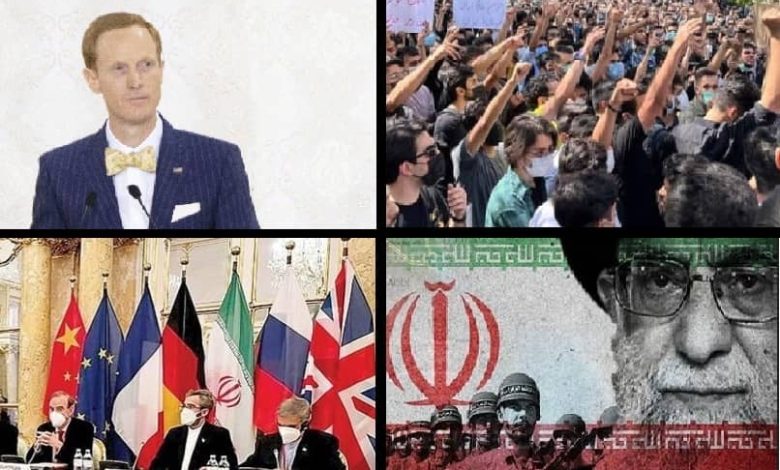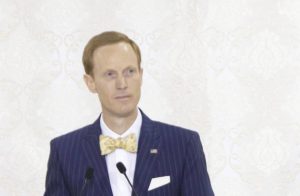Prof. Sheehan Discusses IRGC, Iran Protests and Nuclear Dosier- Interview

Written by
Shamsi Saadati
NCRI’s Foreign Affairs Committee sat down for an interview with Prof. Ivan Sascha Sheehan to talk about the 72-day nationwide uprising in Iran. Prof. Ivan Sascha Sheehan is the executive director of the School of Public and International Affairs at the University of Baltimore. Follow him on Twitter @ProfSheehan.
The text of the interview follows:
NCRI FAC: We are now in the 9th week of the Iranian uprising. Is it possible for the Iranian regime to give up and stand down if the protests continue?

Prof. Sheehan: The final outcome of the uprisings may seem uncertain. But what is clear and tangible at this moment is that the regime has failed to quash or at least control the situation. And it is not as if Tehran hasn’t tried. The highest authorities, including the duo of Supreme Leader Ali Khamenei and the Commander-in-Chief of the Islamic Revolutionary Guard Corps (IRGC) Hossein Salami, have on several occasions bluntly threatened protesters to return home. The fact that the protesters have not backed down is not only embarrassing for the regime, but it reveals Tehran’s fundamental cracks and weaknesses. Just days ago, the regime’s Judiciary Chief threatened protesters with capital punishment. Furthermore, the IRGC is heavily involved in the crackdown, unleashing its brutality daily. But the persistence of the uprising is a vitally significant sign of its longevity and growing intensity. In that sense, this can be called a revolution in the making because the clerical establishment is running out of options and the people are gaining courage and momentum. But it would be wrong to assume that the regime will give up or stand down on its own accord. The people will still need to continue their uprising and resistance, especially against the theocracy’s suppressive forces. And the international community needs to step up support for the Iranian people, particularly the people’s calls to legitimately defend themselves by any means, to blunt the theocracy’s brutality and suppression. That will ensure that the “revolution in the making” will persist, further weakening the regime and ultimately unseating it.
The IRGC and Basij forces use violent forces to prevent demonstrations. Will this affect the protests in Iran, and will they be able to push the protesters back?
Prof. Sheehan: So far, despite the IRGC’s heavy crackdown, the protests have persisted. This is while, according to classified information obtained by the Iranian Resistance, Salami and other senior commanders of the IRGC are leading the regime’s response. Yet protests have impacted at least 252 cities. Despite the heavy cost of participating in street protests – thus far over 660 people have been killed and more than 30,000 have been arrested – young people are unfazed and women continue to lead the uprising. There are other signs that people are more fearless and determined than ever. Some of the heaviest killings and suppressive actions have taken place in Sistan and Baluchestan over the past two months. Yet as late as Friday, November 10, people came out with more ferocity. Protest rallies were reported in Zahedan, Khash, Rask, and Saravan. People chanted slogans like “Death to Khamenei!” and “Death to the Basij!” Even when security forces opened fire and tried to disperse the protesters, the rallies continued. On each martyr’s 40th death anniversary, people find the occasion to rise up again, which points to more upcoming protests and clashes against the regime. The protesters’ loss of fear marked a significant turning point in this battle. As many in the press, such as Reuters, CNN, or the New York Times, have discovered, for example: “I have one life and I want to live it freely,” said Shideh, 17. “We are not scared of being killed. We will eventually change the regime.” The facts on the ground speak for themselves and people are showing that they are determined to overthrow the regime despite the brutal crackdown.
#SHEEHAN | #Interview w/ Dr. Ivan Sascha Sheehan on #IranProtests (#Arabic) | Al Bawaba News | 26 NOV 2022 #Iran #IRGC #IranRevolution #HumanRights #MiddleEast @StateDept @SecBlinken @UN @UNSC @UN_HRC #ForeignPolicy #GlobalAffairs @ProfSheehan 🌍 pic.twitter.com/olorzjFdag
— Ivan Sascha Sheehan, Ph.D. (@ProfSheehan) November 26, 2022
Can we see the return of the Iran nuclear agreement?
Prof. Sheehan: Even in the heyday of Western hopes for a return to the deal, Tehran was deliberately blocking it and using delay tactics, indicating that it is not serious about a mutually successful outcome. This should not come as a surprise. For decades, Tehran has consistently engaged in a longstanding pattern of cheating and deceptive behavior to advance its nuclear ambitions. It has used the negotiation process to reduce international scrutiny while its inches toward the nuclear bomb. And even after the first deal (JCPOA) was signed, Tehran violated the terms consistently. In December 2015, the Institute for Science and International Security published an analysis of a report by the International Atomic Energy Agency (IAEA) on the possible military dimensions of Iran’s nuclear program. It said Tehran violated the JCPOA by refusing to cooperate with the IAEA on the possible military dimensions of the program. In 2017, German intelligence said that even when the US was still part of the JCPOA, the regime attempted more than 100 times to obtain illicit nuclear technology. The Iranian Resistance has also revealed the regime’s bomb-seeking activities on multiple occasions, including ongoing research and development activities at the Parchin military site in 2017, out of reach of IAEA inspectors. Today, with the ongoing unrest in Iran and the international public opinion shifting to the plight of the Iranian people for democracy, it has become even more untenable for western powers to pursue a deal with the devil.
Can Iran’s economic crisis with demonstrations help to take things out of the regime’s control?
Prof. Sheehan: The theocracy has already overstayed its welcome. For the past 43 years, it has been encircled by multiple existential crises but has managed to retain control only through massacres, murders, imprisonment, torture, and brutality. In one instance in 1988, it killed at least 30,000 political prisoners, over 90% of whom were members of the main opposition Mujahedin-e Khalq (MEK). But now things are reaching a breaking point. According to official stats, more than two-thirds of the population live in abject poverty, and the inflation rate is skyrocketing. At the bottom of the simmering unrest is deep public antipathy toward decades of economic mismanagement, institutionalized corruption, deepening social crises, and suppression in almost every sphere of society. In these circumstances, the regime will certainly lose control. It is only a matter of time.
Will more sanctions be applied against the Iranian regime, especially after not reaching solutions to restore the nuclear agreement?
Prof. Sheehan: Indeed, it is imperative to reinstate the six suspended UN Security Council resolutions related to sanctions on the Iranian regime. But sanctions aren’t enough. History has shown time and again that the right policy to deal with the Iranian regime is not leniency and dialogue, but firmness and decisiveness. Western capitals must be alive to this reality. During the past two months of uprisings, the regime has killed dozens of children. The international community cannot continue to negotiate with a child-murdering theocracy. As part of a decisive policy, the regime must be expelled from the United Nations and all its institutions. Critically, the international community must recognize the Iranian people’s right to self-defense and overthrow the regime, while acknowledging that the youths’ struggle against the IRGC is legitimate and necessary. The regime’s embassies in Western countries must be closed. And the suppressive IRGC must be designated as a terrorist entity.

